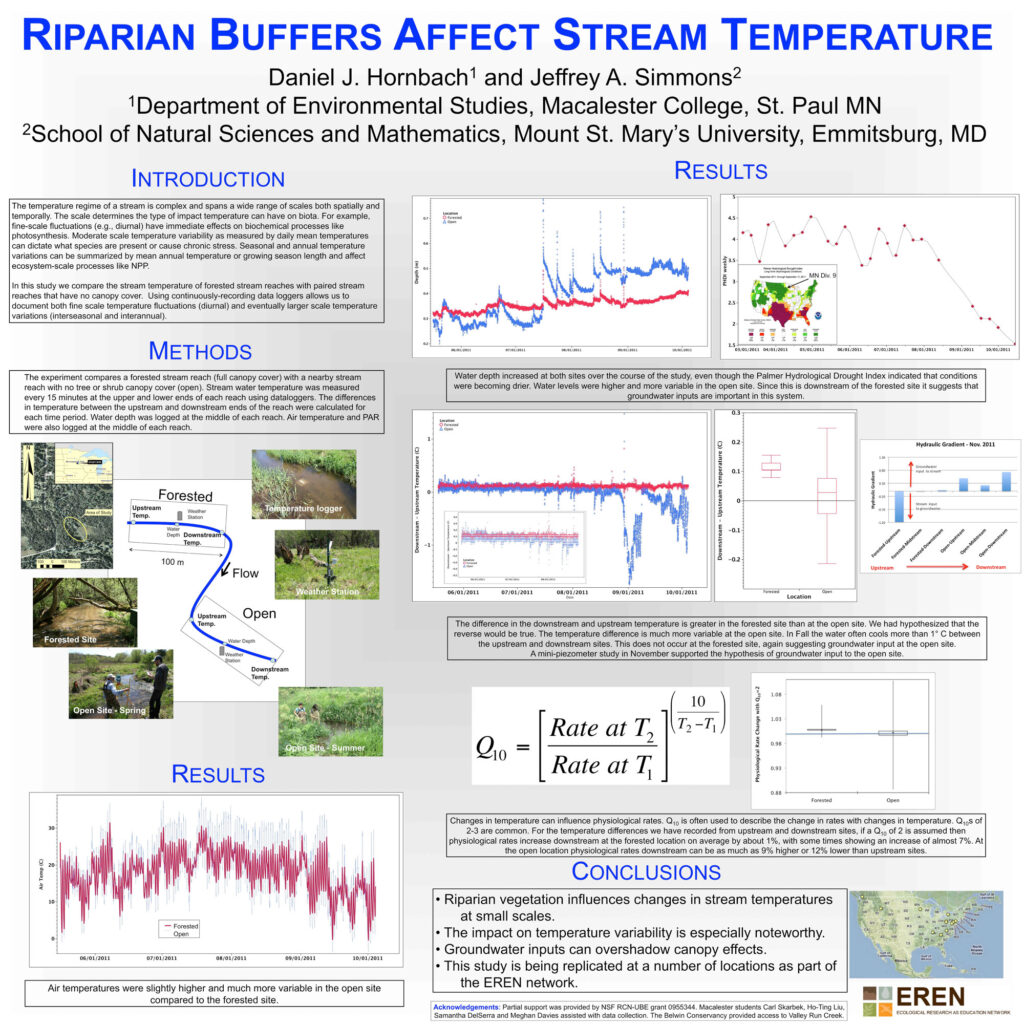The experiment compares a forested stream reach (full canopy cover) with a nearby stream reach with no tree or shrub canopy cover (open) of Valley Creek in east-central Minnesota. The section of the stream we are studying is located at the Belwin Conservancy. Stream water temperature was measured every 15 minutes at the upper and lower ends of each reach using dataloggers. The differences in temperature between the upstream and downstream ends of the reach were calculated for each time period. Water depth was logged at the middle of each reach. Air temperature and PAR were also logged at the middle of each reach.
The following abstract was for the Society for Freshwater Science meetings in Lexington, KY, May 2012:
| Riparian Buffers Affect Stream Temperature Daniel J. Hornbach1 and Jeffrey A. Simmons2 1Department of Environmental Studies, Macalester College, St. Paul MN 2School of Natural Sciences and Mathematics, Mount St. Mary’s University, Emmitsburg, MD The temperature regime of a stream spans a range of spatial and temporal scales that can influence biota. Fine-scale fluctuations may have immediate effects on processes like photosynthesis, while moderate scale variability can dictate what species are present and seasonal variations can affect ecosystem-scale processes like NPP. We compared the stream temperature in a 3rd order stream in MN. Stream temperature was measured every 15 minutes at the upper and lower ends of a forested reach and compared to a paired reach having no canopy cover. The difference in downstream and upstream temperature was greater in the forested site than at the open site. We had hypothesized the reverse would be true. The temperature difference is more variable at the open site. In fall, the water cooled between upstream and downstream sites. This does not occur at the forested site, suggesting groundwater input at the open site. A mini-piezometer study supported this hypothesis. Overall, riparian vegetation influenced changes in stream temperatures at small scales with the greatest impact on temperature variability. However, we found groundwater inputs can overshadow canopy effects. |

The following abstract was for the Ecological Society of America Meeting, Portland, OR, August 2012:
| PS 2-50 – Effect of Fiparian Shade on Stream Water Temperature: A Collaboration Among Eleven Primarily Undergraduate Institutions Jeffrey A. Simmons, Mount St. Mary’s University, Emmitsburg, MD, Michelle L. Anderson, University of Montana Western, Dillon, MT, William J. Dress, Robert Morris University, Moon Twp., PA, Jennifer Frick-Ruppert, Brevard College, Brevard, NC, Catherine J. B. Hanna, Robert Morris University, Moon Twp., PA, Daniel Hornbach, Macalester College, St. Paul, MN, Alida Janmaat , University of the Fraser Valley, Abbotsford, BC, Canada, Frank Kuserk, Moravian College, Bethlehem, PA, James G. March, Washington and Jefferson College, Washington, PA, Tom Murray , Elizabethtown College, Elizabethtown, PA, John Niedzwiecki , Belmont University, Nashville, TN, Darlene Panvini , Belmont University, Nashville, TN, Bob Pohlad , Ferrum College, Ferrum, VA, Carolyn L. Thomas, Ferrum College, Ferrum, VA, Liette Vasseur, Brock University, St Catharines, ON, Canada Through the Ecological Research as Education Network, researchers from the United States and Canada have been developing collaborative research projects aimed at analyzing broad ecological patterns. The Riparian Buffers Affect Stream Temperature (RBAST) project is one of these activities. Temperature variation across ecosystems can be assessed at various spatial and temporal scales. These variations in spatiotemporal patterns can be found in terrestrial and aquatic systems and significantly influence ecosystem functions and structure. This project examines the effect of riparian shade on the temperature regime of streams (1-3 order) at eleven locations across the United States and Canada. At each site, we paired a forested stream (>90% canopy cover) with an adjacent or nearby open stream (<10% canopy cover). To measure fine scale temporal variation, water temperatures were measured every 15 minutes using data loggers at the upper and lower ends of each reach. Also air temperature, canopy cover, channel width and depth, light levels, and discharge were measured for each reach. At five sites, we continuously monitored air temperature and PAR in each reach. Results varied among sites. Mean daily temperature differences between upstream and downstream ends of the reach were significantly greater in open streams in most sites indicating that the open reaches had a greater net heat flux than forested reaches at these locations. Maximum temperature differences between upstream and downstream ends of the open reach averaged between 0.34 and 2.9oC. The daily fluctuation in temperature was significantly greater in open streams due mainly to greater daily maximum temperatures (as much as 8.4°C) in the open stream. Extreme temperature fluctuations may act as pulsed disturbances on aquatic organisms. Stream temperature daily means and maxima were significantly correlated with air temperature among and within sites, highlighting the importance of this factor. Additional data at one of the open sites suggested groundwater inputs buffered diel temperature fluctuations. The significance of this study is twofold. First, it demonstrates that factors such as groundwater inputs and variability among microhabitats can overshadow the effect of canopy cover in influencing temperature regime of a stream. Second, cross continental collaboration can improve our ability to understand the inherent variability among stream ecosystems. Organizations such as EREN, which facilitate these sorts of collaborations, are essential, especially for researchers/educators at primarily undergraduate institutions where time for fieldwork is often limited. |
